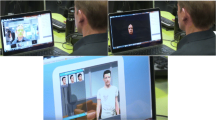Abstract
Room-scale virtual reality (VR) holds great potential as a medium for communication and collaboration in remote and same-time, same-place settings. Related work has established that movement realism can create a strong sense of social presence, even in the absence of photorealism. Here, we explore the noteworthy attributes of communicative interaction using embodied minimal avatars in room-scale VR in the same-time, same-place setting. Our system is the first in the research community to enable this kind of interaction, as far as we are aware. We carried out an experiment in which pairs of users performed two activities in contrasting variants: VR vs. face-to-face (F2F), and 2D vs. 3D. Objective and subjective measures were used to compare these, including motion analysis, electrodermal activity, questionnaires, retrospective think-aloud protocol, and interviews. On the whole, participants communicated effectively in VR to complete their tasks, and reported a strong sense of social presence. The system’s high fidelity capture and display of movement seems to have been a key factor in supporting this. Our results confirm some expected shortcomings of VR compared to F2F, but also some non-obvious advantages. The limited anthropomorphic properties of the avatars presented some difficulties, but the impact of these varied widely between the activities. In the 2D vs. 3D comparison, the basic affordance of freehand drawing in 3D was new to most participants, resulting in novel observations and open questions. We also present methodological observations across all conditions concerning the measures that did and did not reveal differences between conditions, including unanticipated properties of the think-aloud protocol applied to VR.
Similar content being viewed by others
Notes
- 1.
CocoVerse, https://github.com/cocoverse.
- 2.
The Game Gal, https://www.thegamegal.com/.
References
Bailenson, J.N., Swinth, K., Hoyt, C., Persky, S., Dimov, A., Blascovich, J.: The independent and interactive effects of embodied-agent appearance and behavior on self-report, cognitive, and behavioral markers of copresence in immersive virtual environments. Presence Teleoperators Virtual Environ. 14(4), 379–393 (2005). http://www.mitpressjournals.org/doi/10.1162/105474605774785235
Bailenson, J.N., Yee, N.: Digital chameleons: automatic assimilation of nonverbal gestures in immersive virtual environments. Psychol. Sci. 16(10), 814–819 (2005). http://dx.doi.org/10.1111/j.1467-9280.2005.01619.x
Blascovich, J.: Social influence within immersive virtual environments. In: Schroeder, R. (ed.) The Social Life of Avatars. Computer Supported Cooperative Work, pp. 127–145. Springer, London (2002). doi:10.1007/978-1-4471-0277-9_8
Davidson, J.N., Campbell, D.A.: Collaborative design in virtual space - greenspace ii: a shared environment for architectural design review. In: McIntosh, P., Ozel, F. (eds.) Design Computation: Collaboration, Reasoning, Pedagogy: Acadia Conference Proceedings, pp. 165–179. ACADIA, Tucson, October 1996. http://papers.cumincad.org/cgi-bin/works/Show?c7d4
Doberenz, S., Roth, W.T., Wollburg, E., Maslowski, N.I., Kim, S.: Methodological considerations in ambulatory skin conductance monitoring. Int. J. Psychophysiol. 80(2), 87–95 (2011)
Fox, J., Ahn, S.J.G., Janssen, J.H., Yeykelis, L., Segovia, K.Y., Bailenson, J.N.: Avatars versus agents: a meta-analysis quantifying the effect of agency on social influence. Hum. Comput. Interact. 30(5), 401–432 (2015). http://www.tandfonline.com/doi/full/10.1080/07370024.2014.921494
Garau, M., Slater, M., Vinayagamoorthy, V., Brogni, A., Steed, A., Sasse, M.A.: The impact of avatar realism and eye gaze control on perceived quality of communication in a shared immersive virtual environment. In: Proceedings of the Conference on Human Factors in Computing Systems - CHI 2003, p. 529. ACM Press, New York, April 2003. http://portal.acm.org/citation.cfm?doid=642611.642703
Greenwald, S.W., Corning, W. Maes, P.: Multi-user framework for collaboration and co-creation in virtual reality. In: Proceedings of the 12th International Conference on Computer Supported Collaborative Learning (2017). http://hdl.handle.net/1721.1/108440
Hollan, J., Stornetta, S.: Beyond being there. In: Proceedings of the SIGCHI Conference on Human Factors in Computing Systems, CHI 1992, pp. 119–125. ACM, New York (1992). http://doi.acm.org/10.1145/142750.142769
Isaacs, E.A., Tang, J.C.: What video can and cannot do for collaboration: a case study. Multimedia Syst. 2(2), 63–73 (1994). http://link.springer.com/10.1007/BF01274181
Kim, S., Lee, G., Sakata, N., Billinghurst, M.: Improving co-presence with augmented visual communication cues for sharing experience through video conference. In: 2014 IEEE International Symposium on Mixed and Augmented Reality (ISMAR), pp. 83–92. IEEE, September 2014. http://ieeexplore.ieee.org/lpdocs/epic03/wrapper.htm?arnumber=6948412
Okada, K.I., Maeda, F., Ichikawaa, Y., Matsushita, Y.: Multiparty videoconferencing at virtual social distance. In: Proceedings of the 1994 ACM Conference on Computer Supported Cooperative Work - CSCW 1994, pp. 385–393. ACM Press, New York, October 1994. http://portal.acm.org/citation.cfm?doid=192844.193054
Slater, M., Sanchez-Vives, M.V.: Transcending the self in immersive virtual reality. Computer 47(7), 24–30 (2014)
Acknowledgements
We would like to thank Hisham Bedri and Ronen Zilberman for their contributions to the project, and Chris Schmandt for his useful feedback.
Author information
Authors and Affiliations
Corresponding author
Editor information
Editors and Affiliations
1 Electronic supplementary material
Below is the link to the electronic supplementary material.
Supplementary material 1 (mp4 201864 KB)
Rights and permissions
Copyright information
© 2017 Springer International Publishing AG
About this paper
Cite this paper
Greenwald, S.W., Wang, Z., Funk, M., Maes, P. (2017). Investigating Social Presence and Communication with Embodied Avatars in Room-Scale Virtual Reality. In: Beck, D., et al. Immersive Learning Research Network. iLRN 2017. Communications in Computer and Information Science, vol 725. Springer, Cham. https://doi.org/10.1007/978-3-319-60633-0_7
Download citation
DOI: https://doi.org/10.1007/978-3-319-60633-0_7
Published:
Publisher Name: Springer, Cham
Print ISBN: 978-3-319-60632-3
Online ISBN: 978-3-319-60633-0
eBook Packages: Computer ScienceComputer Science (R0)




